Cheers to
Nature's Creepy-Crawlies
By
Gary Greenberg
SuperWriter, Inc.
Normally, we like to enjoy beer with family and friends. For
me, this includes my best furry friend Roxanne. She’s mostly
American Staffordshire
terrier (aka pit
bull) with
maybe a little boxer thrown in.
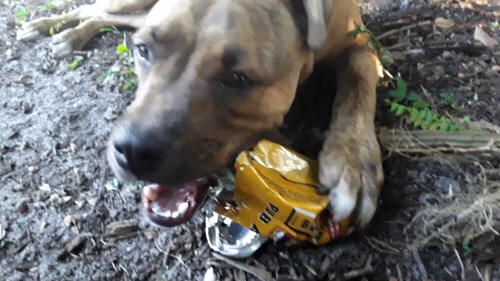
Roxanne's hoppy hour
|
Roxanne always joins me for my “hoppy” hour beer
out by the
turtle pen. While I quaff a high potency craft beer or
homebrew, Roxanne
enjoys chewing up beer cans, as depicted in The Beer Diet Guy YouTube
video, Roxanne,
You Don’t Have to Chew That Can Tonight.
And while we sip and chew, we feed some super-worms to our
red-spotted turtle pal Dottie, who is a reptile. In general, reptiles
are quite
misunderstood. Just because they are not soft and cuddly, and a very
small
percentage of them are poisonous, people tend to be fearful or even
repulsed by
them.
I happen to like reptiles because they are cool-looking and make
for good, low maintenance pets. Of course, the anoles, bearded dragons
and
turtles I have befriended are all non-venomous. But ironically,
venomous
reptiles have actually benefitted mankind the most.
Take the Gila monster for example. This southwestern
American desert-dweller could almost kill you with its looks, and
it’s one of
only two North American lizards with a venomous bite. Yet the Gila
monster is your
friend, especially if you’re diabetic.
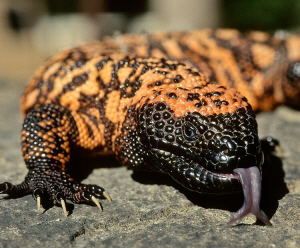
Gila monster
|
That’s because an injectable drug derived from the Gila
monster’s
venom helps diabetes sufferers maintain healthy blood sugar levels.
“Since the Gila monster sleeps all winter without eating, its
pancreas shrinks and has to wake up in the spring,” says Dr. Leslie
Boyer, Ph.D., founding director of the Venom, Immunochemistry,
Pharmacology and Emergency Response Institute (VIPER) at the University
of
Arizona’s College of Medicine. “The chemicals in
its venom that
stimulate the metabolism of its own pancreas also work on humans. So
the same thing
that helps the Gila monster enjoy its lunch can help
diabetics.”
Like the Gila monster, venoms from various reptiles
and other creepy-crawlies can also be used to heal. They are
fast-acting and
efficient in targeting molecules that cause disease, all due to how
venomous
creatures evolved alongside mammals.
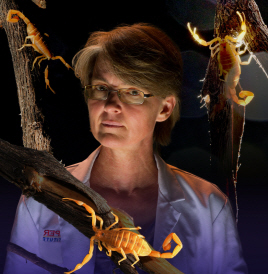
Dr. Leslie Boyer
|
“As prey developed more complex systems to
ward off venoms, the venoms adapted to become more efficient in doing
something
to nerves or the heart or to make blood vessels leak,”
explains Boyer. “Now, these venoms are like a key for
unlocking many targets in the human
body. In large doses, they cause harm. But if we dole them
out in little
spritzes, they can become drugs to treat nerve pain or heart problems
or blood
clotting.”
Here are some of Mother Nature’s creepy critters whose
venoms and other biological compounds help heal humans
from what
ails them:
Cone snail:
The potent venom
from this is fish-eating mollusk has as many as 200 different
compounds, making
it a veritable motherlode for possible pharmaceutical uses. In 2004,
the government’s
Food and Drug Administration approved a pain medication derived from
one of the
venom’s peptides. And scientists hope that other compounds
may lead to drugs
for epilepsy, heart disease and stroke.
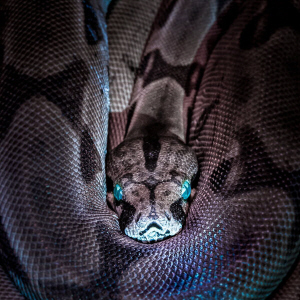
Brazilian pit viper
|
Brazilian
Pit Viper: The
venom from this South
American snake was used by scientists to develop one of the first ACE
inhibitors, a type of medication to treat hypertension and congestive
heart
failure.
Caribbean Sea Sponge: Two
chemicals found in this
large, shallow-water sponge have been used in developing anti-viral and
anti-cancer medications, including AZT, a breakthrough AIDS treatment.
Coho Salmon: Besides
offering a wealth of
nutrition when eaten, a hormone that Coho secrete to regulate their
calcium
levels led to the development of drugs called calcitonin-salmon that
help aging
humans prevent bone loss.
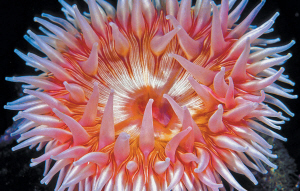
Sea anemone
|
Sea Anemone:
Peptides from the venom of
this saltwater invertebrate block selective potassium channels, which
tend to
be defective in autoimmune disease sufferers. Early trials of a medication derived
from these peptides show promise in treating multiple sclerosis,
rheumatoid
arthritis, psoriasis and other autoimmune conditions.
Horseshoe Crab:
After surviving for more than 200 million years, horseshoe crabs have
seen it
all as far as pathogens go. Their blue blood reacts to dangerous
microbes and
toxins by coagulating. Scientists today use this blood reaction to
detect
contamination in vaccines, antibiotics and implanted devices.
Maggots:
These fly larvae feast on decaying matter and thereby gross out most
humans. But they can be a lifesaver for people with chronic wounds and
infections. By eating away diseased tissue, maggots can help save body
parts
from amputation. “I call them micro-surgeons,”
says Oregon-based dermatologist Dr. Edgar Maeyens Jr. “Those
little guys can (clean)
a wound better than any guy with a knife.”
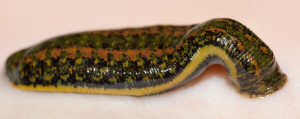
Leech
|
Leeches: The
bloodsuckers have been
used medicinally for more than 2,500 years. In olden times, they
removed “bad”
blood which was thought to cause disease. These days, they are mainly
used in
body part reattachment. While doctors repair arteries, small veins are
left
traumatized and unable to carry blood back into the circulatory system.
Leeches
serve as makeshift veins to sop up blood until the body can produce new
veins.
|